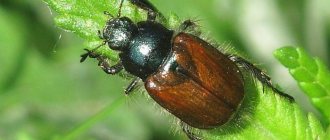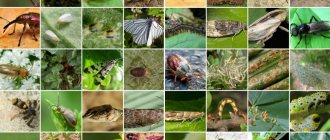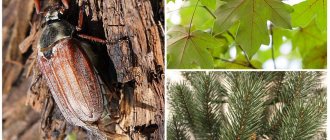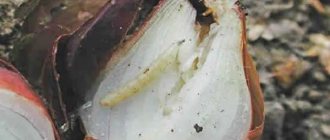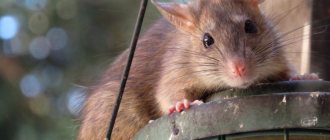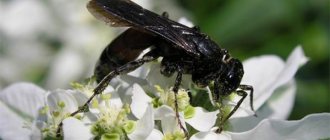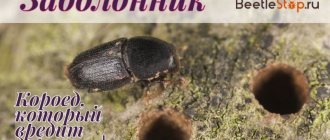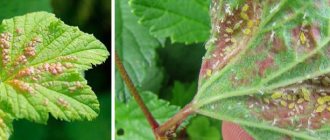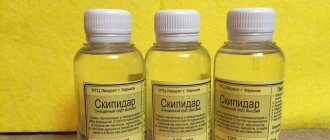Drill-driver DEKO GCD12DU3 Li-ion, 1x1.5Ah, Replaceable battery, 12 V, 32 Nm, 1 battery
1697 ₽ More details
Drill/driver DEKO DKCD16FU Li-ion in case + 63 accessories, 2x1.5Ah, Replaceable battery, 16 V, 32 Nm, 2 batteries
3168 ₽ More details
Tanning oils
Small in size, with a bright interesting color, attracting attention - this is the blister beetle. But appearances are deceiving and touching an insect in some conditions is life-threatening.
Blister beetles can be very dangerous
Blister beetles: photo
Blister beetles.
Who are the naryvniki
Name: family Blisters Lat.: Meloidae
Class: Insects - Insecta Order: Coleoptera - Coleoptera
| Habitats: | steppe, semi-desert, tropics |
| Dangerous for: | many plants, people and animals |
| Means of destruction: | depend on the species, from biological to chemical methods |
Blisters are representatives of one of the most famous families of Coleoptera. These insects stand out from the rest due to their bright color, the presence of strong poison in the blood and the interesting lifestyle of their larvae.
What do blisters look like?
Life cycle of a blister beetle.
Most members of the blister family are medium or large-sized bugs. Their body length can vary from 5 mm to 50 mm. The head is round or triangular in shape, and is equipped with complex faceted eyes and antennae. The latter consist of 8-11 segments and in most species they are slightly expanded towards the upper edge.
The pronotum in many representatives of this species is the narrowest part of the body. The elytra are quite elastic, oblong in shape and most often painted in bright colors. The most popular color options for elytra:
- bright red with black dots;
- black with yellow-orange spots and wide stripes;
- green with a metallic sheen;
- bright orange with small black spots;
- black or blue-black with a metallic sheen.
Female and male individuals usually do not have striking external differences, but in some species one can observe a strong increase in the abdomen in females, or modified antennae in males.
Blister beetles.
Many species of blister bugs boast well-developed wings, making them considered skilled flyers. The legs of representatives of this family are well adapted for walking and running. There are a number of spurs on the shins.
At the larval stage, blister bugs are very active and lead a predominantly parasitic lifestyle. Immediately after birth, they have well-developed legs and their main goal is to move to a place where there is a suitable food source for them. At the next stages of development, the larva spends almost all its time eating.
The best drugs
Manufacturers produce a wide range of products designed to combat tree pests. The action of these drugs can only be effective if the instructions for their use are strictly followed.
"Clipper"
The Russian drug belongs to a new generation of insecticides. Has a universal effect. In addition to fighting barbels, Clipper is used to destroy typograph bark beetles and other tree pests. The product contains bifethrin. This compound belongs to the class of synthetic pyrethroids.
In trade, the product is presented in the form of a suspension, poured into 5 liter canisters. The action of "Clipper" is enteric-contact. When it enters the body of pests, it causes paralysis.
Treatment of areas infested with longhorned beetles is carried out a week before the start of the mass summer. To do this, all trees and shrubs growing in the contaminated area are sprayed with the product.
Advantages:
- versatility of use;
- does not accumulate in soil and plant tissues;
- fast and long-lasting protective effect;
- does not cause resistance;
- safe for humans and pets;
- compatible with pesticides.
Disadvantage : toxic to beneficial insects.
Spraying of trees with the drug is carried out in calm weather, observing all the necessary precautions. Repeated treatment is carried out after 15-20 days.
Review
| Julia G. |
| I bought the drug to fight barbels, but I also use it for other purposes. I use it to kill spider mites, aphids and whiteflies. A very effective remedy. |
"Anti shashel"
The main purpose of the product is to combat shawl, but it can also effectively destroy longhorned beetles. The drug is an organic solvent. It is only dangerous for chitin-containing insects. Inject it with a syringe into the holes made by insects in the wood.
The properties of Antishashelin last for 10 years. The composition of the drug contains silicones. They are able to penetrate deeply into the wood structure. When processing wood products, the product preserves their integrity and leaves no traces of use.
Advantages:
- high penetrating ability;
- effectively destroys insect larvae;
- eliminates the possibility of insects developing immunity to its use;
- resistant to light;
- ensures 100% destruction of pests;
- retains its properties for a long period.
Disadvantage : When working with the drug, precautions must be taken.
Review
| Leonid S. |
| I bought a product for treating the walls of a log house in the country. The expense is high, the work is painstaking, but the result is pleasing. |
"The Tree Doctor"
The product is available in 5 brands that have different effects. The drug under the brand name “4” is an alcohol or aqueous solution. Brands 1, 2, 3 and 5 are only aqueous solutions. All of them are biologically active substances. The main purpose of the “Wood Healer” is to protect wood from pests, as well as from fungal bacteria that cause blue stains, rot and mold.
Depending on the brand of the drug, it is used:
- M 1 – for antiseptic treatment of lumber intended for the construction of dry, heated and well-ventilated buildings.
- M 2 – for processing wooden structures operating in areas with high humidity and large seasonal temperature changes.
- M 3 and M 4 - for the antiseptic treatment of wooden buildings that are buried in the ground and located in areas of increased risk of biocontamination.
- M 5 is a universal remedy.
All types of products are applied with a roller to the surface of the wood. The average consumption of the drug is 300 g/1 sq.m.
Advantages:
- high efficiency;
- wide spectrum of action;
- reliable protection of wooden structures from biocontamination.
Flaw:
- high consumption.
Review
| Mikhail L. |
| I constantly buy a product for treating boards. It’s expensive, but before using it I lost much more due to damage to the boards by pests, blue and black rot. |
"Anti-bug"
The product belongs to the neomid group. This is a universal drug designed to combat all types of tree pests.
It is safe for humans, which allows it to be used for processing wooden buildings not only outside, but also inside. The antiseptic is not susceptible to moisture.
To treat the surface of wood, use a solution prepared on the basis of Anti-Bug. Dilute it with water in a ratio of 1:4.
Apply the liquid prepared in this way onto a wooden surface using a roller in three layers. The surface must be dry and clean, free from paint and varnish coatings.
Advantages:
- environmental Safety;
- deep penetration into wood tissue;
- complex protective properties;
- resistance to precipitation and washability;
- no unpleasant odor;
- long period of action.
Disadvantage : When working with the drug, precautions must be taken.
Review
| Kirill I. |
| The drug does a good job of protecting wood from pests, but is weak to combat insects already living in it. |
"Empire-20"
The Spanish-made insecticide is widely known as an effective remedy for controlling bedbugs, but can also be used to kill longhorned beetles.
It is low toxic, leaves no traces of processing and does an excellent job of killing adult insects and larvae. The best time to treat areas or wooden structures infested with longhorned beetles is considered to be May-June.
During this period, insects mate and the maximum effect of the treatment can be achieved. The product is used in the form of a solution, which is evenly sprayed over the surface of the wood. "Empire-20" is produced in the form of a liquid bottled in bottles. After treatment, all insects, including larvae, die within 24 hours.
Advantages:
- high efficiency;
- versatility of use;
- does not require re-processing.
Flaws:
- high price;
- the need to take precautions when working.
Review
| Maxim Ch. |
| With the help of Empire-20, I removed not only longhorned beetles from the dacha, but also all cockroaches. I am very pleased with the product. |
Blister Habitat
For a long time, the habitat of blister beetles was limited to the countries of Europe, Asia and Africa. Insects prefer open steppe and semi-desert areas, and due to their heat-loving nature, the bulk of these beetles are found in tropical and subtropical zones. At the moment, these bright bugs can be found on all continents except Antarctica.
Schiffer's blister.
Within Russia, different types of blister beetles live in the following areas of the country:
- South-Eastern regions;
- European part of the country;
- Southwestern and Eastern Siberia;
- Primorye;
- North Caucasus.
Blister lifestyle
Adults of most blister species feed exclusively on food of plant origin. Some representatives are aphages and do not need food at all. The diet of adults may include:
- leaves;
- young shoots;
- inflorescences;
- flower nectar.
The larvae are mostly parasites . Blisters most often lay their eggs near the home of a potential victim, which could be:
- bees;
- wasps;
- grasshoppers;
- locusts
Larval transport
Small blister beetles on a flower.
Thanks to its well-developed limbs, soon after birth the larva climbs up plant stems and waits for a suitable candidate. As soon as a potential “breadwinner” appears on the horizon, it quietly attaches itself to his body. The unsuspecting victim delivers the dangerous parasite directly to its nest, where the larva descends from its “transport” and begins to consume food. Her diet may include:
- oviposition;
- larvae;
- food supplies stored by adult insects for their offspring.
Own observations
When carefully studying the appearance of the T-shirt, I never ceased to be amazed at the perfection of the shape of the insect and the geometry of the elements of its body: the cup-elytra, the ideally rectangular body, the triangular head, the antennae-beads.
I was especially struck by the beetle’s paws and their incredibly complex structure. I thought that a human hand, compared to the foot of an ordinary T-shirt, looks much simpler.
While looking at the beetle, I couldn’t help but think how good it is that we don’t live in the times of giant insects. Humanity would have a noticeable increase in problems if it were to encounter something like this. Well, or it simply would not have become the dominant species, destroying the world in which it lives.
Man often tries to classify representatives of the animal world (in particular, insects) based solely on his own (not always ideal) considerations of the beautiful and useful. However, we should not forget that there are other standards that differ from human ones. In nature, every type of living being has the right to a place in the sun, regardless of whether it is useful or beautiful for the person who evaluates it.
Harm and benefit from blisters
Since adult blister beetles are phytophagous, some of their species can harm crops. This most often occurs during periods of strong population growth. The following plant species most often suffer from blister infestations:
- legumes;
- potato;
- strawberry;
- onion;
- oats;
- asparagus.
For people and animals
Blister venom is dangerous to people.
Due to the fault of adult blister beetles, not only plants, but also animals . Since the hemolymph of these insects contains a dangerous toxin, they pose a threat to almost all living organisms. The beetles spend most of their time on the leaves and inflorescences of the plant, so livestock grazing in the fields often eats them along with the grass. Such an addition to a plant-based meal can be dangerous to the life and health of the animal.
Blister venom can also be dangerous to humans . Even for an adult, healthy person, one insect eaten can cost his life. If you pick up this beetle with your bare hands, it will sense danger and, in self-defense, will release toxic hemolymph from special glands on its legs. After contact with a toxic substance, very unpleasant symptoms begin to appear on the skin:
- burning;
- itching;
- redness;
- formation of blisters and abscesses.
The only benefit that blister beetles can bring is pollination of plants. Species that feed on flower nectar contribute to the pollination of a huge number of different crops. Moreover, the reproduction of some representatives of the flora directly depends on these insects.
Blister larvae
Unlike adult beetles, blister beetle larvae do more good than harm. They often parasitize locust nests and destroy the young generation, which significantly affects the number of these insects. And as you know, locusts are the most dangerous pests of cultivated plants.
It is worth noting that the young generation of some types of blister bees prefer to parasitize in the nests of honey bees and such proximity can cause serious harm to the bee colony.
Nutrition
What the longhorned beetle eats depends on its habitat. Adult beetles feed on pistils and stamens of flowers, young bark and leaves of bushes and trees. Pieces of fallen or healthy bark, petioles, plant sap, pulp of cacti or other plants - this is what the longhorned beetle feeds on.
That is, an adult beetle is almost harmless. But the larva of the longhorned beetle is a scourge for trees, wooden buildings and wooden objects. They develop in trees and feed on wood, causing enormous harm to forests on the planet.
Many beetles were divided into subspecies precisely due to the choice of the type of tree they chose to feed their larvae. For example, the oak longhorned beetle prefers hardwood trees, oak, for example.
It can settle in oak stumps, as well as in places where the tree is damaged. This beetle is medium in size, 3 to 6 cm, black with a brown tint, and glossy like resin. The elytra are reddish at the tips. In addition to oak, he chooses beech, hornbeam, elm, and walnut for feeding future larvae.
The black or pine longhorned beetle prefers to choose coniferous trees. It is also called the ship beetle. Its larva inexorably destroyed even ready-made ship structures if they were built from infected pine. He himself feeds on pollen, pine needles and leaves.
The beetles that prefer coniferous trees for their clutches - larch, spruce, pine, also include the flat beetle, with a purple color.
The purple longhorned beetle itself feeds on the soft bark of young trees and tender young needles. But its larva causes damage to trees on an almost industrial scale. They continue to destroy wood, even harvested and cut for consumption. They also love to live close to humans, destroying buildings.
The most famous types of blisters
The blister family includes more than 2000 species, but only about 100 of them can be found within Russia. The most common types are:
Use of blisters in folk medicine
The toxic substance contained in the blood of blister beetles is called cantharidin. This toxin is very dangerous to human life and health, but despite this, it was widely used as an aphrodisiac until the 20th century.
Representatives of the species, the Spanish fly, were used to prepare “healing” powders, ointments and tinctures.
The use of such drugs, even in small quantities, ultimately led to disruption of the functioning of many vital organs, but even knowing this, many people continued to use them.
Spanish fly.
How long do these insects live?
The Mike beetle lives very little. Their entire life span is until reproduction. The male dies immediately after mating. The female dies after laying eggs.
The female of this insect manages to lay from a couple to ten thousand eggs. She lays eggs in peculiar nests. These are not particularly deep holes, going 25-30 millimeters into the soil. She makes the masonry in the form of a heap and sprinkles it with earth. The female of this beetle never starts arranging a new nest without making sure that the previous one is completely complete.
